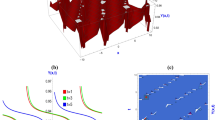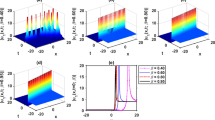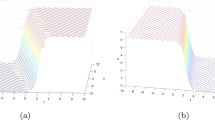Abstract
In this article, the authors proposed a meshfree approach for simulation of non-linear Schrödinger equation with constant and variable coefficients. Schrödinger equation is a classical field equation whose principal applications are to the propagation of light in non-linear optical fibers and planar waveguides and in quantum mechanics. First of all, spatial derivatives are discretized by using local radial basis functions based on differential quadrature method (LRBF-DQM) and, subsequently, the obtained system of non-linear ordinary differential equations (ODEs) is solved by fourth-order Runge–Kutta (RK-4). The stability analysis of the proposed approach is discussed by the matrix method. Numerical experiments ensure that the proposed approach is accurate and computationally efficient.












Similar content being viewed by others
References
Argyris J, Haase M (1987) An engineer’s guide to soliton phenomena: application of the finite element method. Comput Methods Appl Mech Eng 61(1):71–122
Ávila A, Meister A, Steigemann M (2017) An adaptive galerkin method for the time-dependent complex Schrödinger equation. Appl Numer Math 121:149–169
Aydın A, Karasözen B (2007) Symplectic and multi-symplectic methods for coupled non-linear Schrödinger equations with periodic solutions. Comput Phys Commun 177(7):566–583
Bashan A, Yagmurlu NM, Ucar Y, Esen A (2017) An effective approach to numerical soliton solutions for the Schrödinger equation via modified cubic b-spline differential quadrature method. Chaos Solitons Fractals 100:45–56
Bellman R, Casti J (1971) Differential quadrature and long-term integration. J Math Anal Appl 34(2):235–238
Borhanifar A, Abazari R (2010) Numerical study of non-linear Schrödinger and coupled Schrödinger equations by differential transformation method. Opt Commun 283(10):2026–2031
Buhmann MD (2003) Radial basis functions: theory and implementations, vol 12. Cambridge University Press, Cambridge
Dag I (1999) A quadratic b-spline finite element method for solving non-linear schrödinger equation. Comput Methods Appl Mech Eng 174(1–2):247–258
Dehghan M (2006) Finite difference procedures for solving a problem arising in modeling and design of certain optoelectronic devices. Math Comput Simul 71(1):16–30
Dehghan M, Abbaszadeh M (2017) The use of proper orthogonal decomposition (POD) meshless RBF-FD technique to simulate the shallow water equations. J Comput Phys 351:478–510
Dehghan M, Abbaszadeh M (2018) Solution of multi-dimensional Klein–Gordon–Zakharov and Schrödinger/gross–Pitaevskii equations via local radial basis functions-differential quadrature (RBF-DQ) technique on non-rectangular computational domains. Eng Anal Bound Elem 92:156–170
Dehghan M, Mohammadi V (2015) The numerical solution of Cahn–Hilliard (CH) equation in one, two and three-dimensions via globally radial basis functions (GRBFS) and RBFS-differential quadrature (RBFS-DQ) methods. Eng Anal Bound Elem 51:74–100
Dehghan M, Mohammadi V (2017) A numerical scheme based on radial basis function finite difference (RBF-FD) technique for solving the high-dimensional non-linear Schrödinger equations using an explicit time discretization: Runge-Kutta method. Comput Phys Commun 217:23–34
Dehghan M, Nikpour A (2013) Numerical solution of the system of second-order boundary value problems using the local radial basis functions based differential quadrature collocation method. Appl Math Model 37(18–19):8578–8599
Dehghan M, Shokri A (2007) A numerical method for two-dimensional Schrödinger equation using collocation and radial basis functions. Comput Math Appl 54(1):136–146
Dehghan M, Taleei A (2010) A compact split-step finite difference method for solving the non-linear schrödinger equations with constant and variable coefficients. Comput Phys Commun 181(1):43–51
Delfour M, Fortin M, Payr G (1981) Finite-difference solutions of a non-linear Schrödinger equation. J Comput Phys 44(2):277–288
Duree GC Jr, Shultz JL, Salamo GJ, Segev M, Yariv A, Crosignani B, Di Porto P, Sharp EJ, Neurgaonkar RR (1993) Observation of self-trapping of an optical beam due to the photorefractive effect. Phys Rev Lett 71(4):533
Fasshauer GE (2007) Meshfree approximation methods with MATLAB, vol 6. World Scientific, Singapore
Franke R (1979) A critical comparison of some methods for interpolation of scattered data. In: Technical Report, Naval Postgraduate School, Monterey, California
Franke R (1982) Scattered data interpolation: tests of some methods. Math Comput 38(157):181–200
Gardner L, Gardner G, Zaki S, El Sahrawi Z (1993) B-spline finite element studies of the non-linear Schrödinger equation. Comput Methods Appl Mech Eng 108(3–4):303–318
Guo L, Guo Y, Billings S, Coca D, Lang Z (2013) The use of volterra series in the analysis of the non-linear Schrödinger equation. Nonlinear Dyn 73(3):1587–1599
Hardy RL (1971) Multiquadric equations of topography and other irregular surfaces. J Geophys Res 76(8):1905–1915
Hardy RL (1990) Theory and applications of the multiquadric–biharmonic method 20 years of discovery 1968–1988. Comput Math Appl 19(8–9):163–208
Hasegawa A, Tappert F (1973) Transmission of stationary non-linear optical pulses in dispersive dielectric fibers. I. Anomalous dispersion. Appl Phys Lett 23(3):142–144
Hong J, Ji L, Liu Z (2018) Optimal error estimate of conservative local discontinuous galerkin method for non-linear schrödinger equation. Appl Numer Math 127:164–178
Jiwari R (2015) A hybrid numerical scheme for the numerical solution of the burgers equation. Comput Phys Commun 188:59–67
Jiwari R, Mittal R, Sharma KK (2013) A numerical scheme based on weighted average differential quadrature method for the numerical solution of burgers equation. Appl Math Comput 219(12):6680–6691
Jiwari R, Singh S, Kumar A (2017) Numerical simulation to capture the pattern formation of coupled reaction–diffusion models. Chaos Solitons Fractals 103:422–439
Jiwari R, Kumar S, Mittal R (2019) Meshfree algorithms based on radial basis functions for numerical simulation and to capture shocks behavior of burgers type problems. Eng Comput 36(4):1142–1168
Kansa EJ (1990) Multiquadricsa scattered data approximation scheme with applications to computational fluid-dynamicsii solutions to parabolic, hyperbolic and elliptic partial differential equations. Comput Math Appl 19(8–9):147–161
Kansa EJ (1990) Multiquadricsa scattered data approximation scheme with applications to computational fluid-dynamicsi surface approximations and partial derivative estimates. Comput Math Appl 19(8–9):127–145
Karamali G, Abbaszadeh M, Dehghan M (2018) The smoothed particle hydrodynamics method for solving generalized variable coefficient Schrödinger equation and Schrödinger–Boussinesq system. Comput Methods Differ Equ 6(2):215–237
Kartashov YV, Malomed BA, Torner L (2011) Solitons in nonlinear lattices. Rev Mod Phys 83(1):247
Kivshar YS, Agrawal G (2003) Optical solitons: from fibers to photonic crystals. Academic Press, Cambridge
Kong L, Hong J, Ji L, Zhu P (2015) Compact and efficient conservative schemes for coupled non-linear Schrödinger equations. Numer Methods Partial Differ Equ 31(6):1814–1843
Korkmaz A, Dağ İ (2009) A differential quadrature algorithm for non-linear Schrödinger equation. Nonlinear Dyn 56(1–2):69–83
Kumar S, Jiwari R, Mittal R (2019) Numerical simulation for computational modelling of reaction–diffusion brusselator model arising in chemical processes. J Math Chem 57(1):149–179
Ledoux V, Van Daele M (2014) The accurate numerical solution of the Schrödinger equation with an explicitly time-dependent hamiltonian. Comput Phys Commun 185(6):1589–1594
Li H, Wang Y (2017) An averaged vector field legendre spectral element method for the non-linear Schrödinger equation. Int J Comput Math 94(6):1196–1218
Lu W, Huang Y, Liu H (2015) Mass preserving discontinuous galerkin methods for Schrödinger equations. J Comput Phys 282:210–226
Ma W-X, Chen M (2009) Direct search for exact solutions to the non-linear schrödinger equation. Appl Math Comput 215(8):2835–2842
Macías-Díaz JE, Tomasiello S (2016) A differential quadrature-based approach a la picard for systems of partial differential equations associated with fuzzy differential equations. J Comput Appl Math 299:15–23
MacKinnon E (1976) De broglies thesis: a critical retrospective. Am J Phys 44(11):1047–1055
Meng G-Q, Gao Y-T, Yu X, Shen Y-J, Qin Y (2012) Multi-soliton solutions for the coupled non-linear Schrödinger-type equations. Nonlinear Dyn 70(1):609–617
Mittal R, Jiwari R, Sharma KK (2012) A numerical scheme based on differential quadrature method to solve time dependent burgers equation. Eng Comput 30(1):117–131
Mollenauer LF, Stolen RH, Gordon JP (1980) Experimental observation of picosecond pulse narrowing and solitons in optical fibers. Phys Rev Lett 45(13):1095
Neugebauer G, Meinel R (1984) General n-soliton solution of the akns class on arbitrary background. Phys Lett A 100(9):467–470
Nohara BT (2007) Governing equations of envelopes created by nearly bichromatic waves on deep water. Nonlinear Dyn 50(1–2):49–60
Robinson M (1997) The solution of non-linear Schrödinger equations using orthogonal spline collocation. Comput Math Appl 33(7):39–57
Schrödinger E (1926) An undulatory theory of the mechanics of atoms and molecules. Phys Rev 28(6):1049
Scott AC, Chu F, McLaughlin DW (1973) The soliton: a new concept in applied science. Proc IEEE 61(10):1443–1483
Simmons GF (2016) Differential equations with applications and historical notes. CRC Press, Boca Raton
Sun Z (2019) A meshless symplectic method for two-dimensional non-linear Schrödinger equations based on radial basis function approximation. Eng Anal Bound Elem 104:1–7
Taha TR (1984) Mj ablowitz, analytical and numerical aspects of certain non-linear evolution equations II. Numerical, nonlinear Schrödinger equation. J Comput Phys 55:203–230
Tomasiello S (2011) A note on three numerical procedures to solve volterra integro-differential equations in structural analysis. Comput Math Appl 62(8):3183–3193
Tomasiello S (2012) Some remarks on a new dq-based method for solving a class of volterra integro-differential equations. Appl Math Comput 219(1):399–407
Wang B, Liang D (2018) The finite difference scheme for non-linear Schrödinger equations on unbounded domain by artificial boundary conditions. Appl Numer Math 128:183–204
Wang J, Wang Y (2018) Numerical analysis of a new conservative scheme for the coupled non-linear Schrödinger equations. Int J Comput Math 95(8):1583–1608
Wendland H (1995) Piecewise polynomial, positive definite and compactly supported radial functions of minimal degree. Adv Comput Math 4(1):389–396
Yadav OP, Jiwari R (2019) Some soliton-type analytical solutions and numerical simulation of non-linear Schrödinger equation. Nonlinear Dyn 95(4):2825–2836
Yang X, Zhang H, Xu D (2014) Orthogonal spline collocation method for the two-dimensional fractional sub-diffusion equation. J Comput Phys 256:824–837
Zakharov V, Shabat A (1973) Interaction between solitons in a stable medium. Sov Phys JETP 37(5):823–828
Zakharov V, Shabat A, Zakharov V, Shabat A (1971) Exact theory of two-dimensional self-focusing and one-dimensional self-modulation of waves in non-linear media. ksper Teoret Fiz 61(1):118134
Zhang L, Liew K-M (2014) An element-free based solution for non-linear Schrödinger equations using the Icvmls–Ritz method. Appl Math Comput 249:333–345
Acknowledgements
The work was supported by the Council of Scientific and Industrial Research (CSIR), New Delhi, India, with grant No.25(0299)/19/EMR-II.
Author information
Authors and Affiliations
Corresponding author
Additional information
Communicated by Antonio José Silva Neto.
Publisher's Note
Springer Nature remains neutral with regard to jurisdictional claims in published maps and institutional affiliations.
Rights and permissions
About this article
Cite this article
Jiwari, R., Kumar, S., Mittal, R.C. et al. A meshfree approach for analysis and computational modeling of non-linear Schrödinger equation. Comp. Appl. Math. 39, 95 (2020). https://doi.org/10.1007/s40314-020-1113-0
Received:
Revised:
Accepted:
Published:
DOI: https://doi.org/10.1007/s40314-020-1113-0




